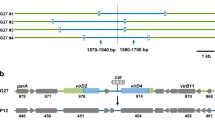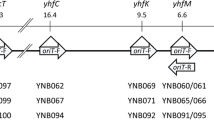Abstract
Three R6K-derived γ ori minireplicons were successfully transferred by conjugation from Escherichia coli to several species of pathogenic bacteria. The pFL129 replicon encodes the wild-type initiation replication protein π, while plasmids pFL130 and pAG101 encode mutant forms of the π protein conferring the plasmid copy-up phenotype. Plasmids could be transferred to all recipient species tested, although high efficiency conjugal transfer was only obtained with genera of the Enterobacteriaceae. The efficiency of plasmid transfer to all recipients was lower for the copy-up derivatives, pFL130 and pAG101, than for pFL129. The three γ ori replicons were stably maintained in all transconjugants except pFL129 in Listeria monocytogenes. The two mutant plasmids retained their copy-up phenotype in the new bacterial hosts.
Similar content being viewed by others
References
Boulos L, Prevost M, Barbeau B, et al. (1999) LIVE/DEAD BacLight: application of a new rapid staining method for direct enumeration of viable and total bacteria in drinking water. J Microb Meth 37:77–86
Crosa JH (1980) Three origins of replication are active in vivo in the R plasmid RSF1040. J Biol Chem 255:11075–11077
de Lorenzo V, Timmis KN (1994) Analysis and construction of stable phenotypes in gram-negative bacteria with Tn5- and Tn10-derived minitransposons. Methods Enzymol 235:386–405
del Solar G, Alonso JC, Espinosa M, et al. (1996) Broad host-range plasmid replication: an open question. Mol Microbiol 21:661–666
Filutowicz M, McEachern MJ, Helinski DR (1986) Positive and negative roles of an initiator protein at an origin of replication. Proc Natl Acad Sci USA 83:9645–9649
Filutowicz M, Rakowski SA (1998) Regulatory implications of protein assemblies at the γ origin of plasmid R6K—a review. Gene 223:195–204
Geromino J, Bastia D (1983) Interaction of the plasmid R6K-encoded replication initiator protein with its binding sites on DNA. Cell 34:125–134
Greerer A, Filutowicz M, McEachern MJ, et al. (1990) N-terminal truncated forms of the bifunctional gp initiation protein express negative activity on plasmid R6K replication. Mol Gen Genet 224:24–32
Haugan K, Karanakaran P, Tondervik A, et al. (1995) The host range of RK2 minimal replicon copy-up mutants is limited by species-specific differences in the maximum tolerable copy number. Plasmid 33:27–39
Inuzuka N, Inuzuka M, Helinski DR (1980) Activity in vitro of three replication origins of the antibiotic resistance plasmid RSF1040. J Biol Chem 255:11071–11074
Kontomichalou P, Mitani M, Clowes RC (1970) Circular R-factor molecules controlling penicillinase synthesis, replicating in Escherichia coli under either relaxed or stringent control. J Bacteriol 104:34–44
Krüger R, Filutowicz M (2003) Characterization of His-tagged R6K-encoded gp protein variants. Plasmid 50:80–85
Kunnimalaiyaan S, Kruger Ross W (2004) Binding modes of the initiator and inhibitor forms of the replication protein π to the γ ori iteron of plasmid R6K. J Biol Chem 279:41058–41066
Kunnimalaiyaan S, Inman RB, Rakowski SA, et al. (2005) Role of π dimmers in coupling (“handcuffing”) of plasmid R6K’s γ ori iterons. J Bacteriol 187:3779–3785
LeRoux F, Binesse J, Saulnier D, et al. (2006) Construction of a Vibrio splendidus Vsm metalloprotease mutant using a novel counter-selectable suicide vector. Appl Environ Microbiol 62:65–74
Levchenko I, Inman RB, Filutowicz M (1997) Replication of the R6K γ origin in vitro: dependence on wt π and hyperactive gpS87N protein variant. Gene 193:97–103
Metcalf WW, Jiang W, Daniels LL, et al. (1996) Conditionally replicative and conjugative plasmids carrying lacZα for cloning, mutagenesis, and allele replacement in bacteria. Plasmid 35:1–13
Miller JH (1972) Appendix I. Formulas and recipes. In: Miller JH (ed) Experiments in molecular genetics. Cold Spring Harbor, NY: CSH Laboratory Press
Molecular Probes (2004) LIVE/DEAD BacLight Bacterial Viability kits—product information. In: Handbook of fluorescent probes and research products, 9th ed
Núñez B, Avila P, de la Cruz F (1997) Genes involved in conjugative DNA processing of plasmid R6K. Mol Microbiol 24:1157–1168
Oshiro EE, Nepomuceno RS, Faria JB, et al. (2006) Site-directed gene replacement of the phytopathogen Xanthomonas axonopodis pv. citri. J Microbiol Methods 65:171–179
Peng Y, Rakowski SA, Filutowicz M (2006) Small deletion variants of the replication protein, π, and their potential over-replication-based antimicrobial activity. FEMS Microbiol Lett 261:245–252
Postafi G, Koob M, Hradecna Z, et al. (1994) In vivo excision and amplification of large segments of the Escherichia coli genome. Nucl Acids Res 22:2392–2398
Reece KS, Philips GJ (1995) New plasmids carrying antibiotic-resistance cassettes. Gene 165:141–142
Schumann R, Schiewer U, Karoten U, et al. (2003) Viability of bacteria from different aquatic habitats. II. Cellular fluorescent markers for membrane integrity and metabolic activity. Aquat Microb Ecol 32:137–150
Simon R, Priefer U, Puhler A (1983) A broad host range mobilization system for in vivo genetic engineering: transposon mutagenesis in Gram negative bacteria. Bio/Technology 1:784–791
Thomas CM (1981) Complementation analysis of replication and maintenance functions of broad host range plasmids RK2 and RP1. Plasmid 5:277–291
Thomas CM (1989) Promiscuous plasmids of gram-negative bacteria. London: San Diego, Academic Press
Wild J, Czyz A, Rakowski SA, et al. (2004) γ origin plasmids of R6K lineage replicate in diverse genera of Gram-negative bacteria. Ann Microb 54:119–128
Acknowledgments
This study was supported by the Polish Ministry of Science through the Faculty of Biology, Warsaw University intramural grants, BW 1636/21 and BW 1680/20.
Author information
Authors and Affiliations
Corresponding author
Rights and permissions
About this article
Cite this article
Grudniak, A.M., Kraczkiewicz-Dowjat, A., Wolska, K.I. et al. Conjugal Transfer of Plasmid R6K γ ori Minireplicon Derivatives from Escherichia coli to Various Genera of Pathogenic Bacteria. Curr Microbiol 55, 549–553 (2007). https://doi.org/10.1007/s00284-007-9032-5
Received:
Accepted:
Published:
Issue Date:
DOI: https://doi.org/10.1007/s00284-007-9032-5




